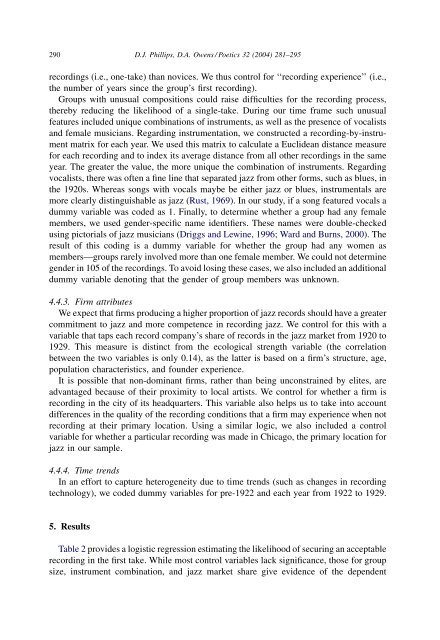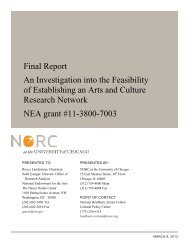Incumbents, innovation, and competence - Cultural Policy Center ...
Incumbents, innovation, and competence - Cultural Policy Center ...
Incumbents, innovation, and competence - Cultural Policy Center ...
You also want an ePaper? Increase the reach of your titles
YUMPU automatically turns print PDFs into web optimized ePapers that Google loves.
290 D.J. Phillips, D.A. Owens / Poetics 32 (2004) 281–295<br />
recordings (i.e., one-take) than novices. We thus control for ‘‘recording experience’’ (i.e.,<br />
the number of years since the group’s first recording).<br />
Groups with unusual compositions could raise difficulties for the recording process,<br />
thereby reducing the likelihood of a single-take. During our time frame such unusual<br />
features included unique combinations of instruments, as well as the presence of vocalists<br />
<strong>and</strong> female musicians. Regarding instrumentation, we constructed a recording-by-instrument<br />
matrix for each year. We used this matrix to calculate a Euclidean distance measure<br />
for each recording <strong>and</strong> to index its average distance from all other recordings in the same<br />
year. The greater the value, the more unique the combination of instruments. Regarding<br />
vocalists, there was often a fine line that separated jazz from other forms, such as blues, in<br />
the 1920s. Whereas songs with vocals maybe be either jazz or blues, instrumentals are<br />
more clearly distinguishable as jazz (Rust, 1969). In our study, if a song featured vocals a<br />
dummy variable was coded as 1. Finally, to determine whether a group had any female<br />
members, we used gender-specific name identifiers. These names were double-checked<br />
using pictorials of jazz musicians (Driggs <strong>and</strong> Lewine, 1996; Ward <strong>and</strong> Burns, 2000). The<br />
result of this coding is a dummy variable for whether the group had any women as<br />
members—groups rarely involved more than one female member. We could not determine<br />
gender in 105 of the recordings. To avoid losing these cases, we also included an additional<br />
dummy variable denoting that the gender of group members was unknown.<br />
4.4.3. Firm attributes<br />
We expect that firms producing a higher proportion of jazz records should have a greater<br />
commitment to jazz <strong>and</strong> more <strong>competence</strong> in recording jazz. We control for this with a<br />
variable that taps each record company’s share of records in the jazz market from 1920 to<br />
1929. This measure is distinct from the ecological strength variable (the correlation<br />
between the two variables is only 0.14), as the latter is based on a firm’s structure, age,<br />
population characteristics, <strong>and</strong> founder experience.<br />
It is possible that non-dominant firms, rather than being unconstrained by elites, are<br />
advantaged because of their proximity to local artists. We control for whether a firm is<br />
recording in the city of its headquarters. This variable also helps us to take into account<br />
differences in the quality of the recording conditions that a firm may experience when not<br />
recording at their primary location. Using a similar logic, we also included a control<br />
variable for whether a particular recording was made in Chicago, the primary location for<br />
jazz in our sample.<br />
4.4.4. Time trends<br />
In an effort to capture heterogeneity due to time trends (such as changes in recording<br />
technology), we coded dummy variables for pre-1922 <strong>and</strong> each year from 1922 to 1929.<br />
5. Results<br />
Table 2 provides a logistic regression estimating the likelihood of securing an acceptable<br />
recording in the first take. While most control variables lack significance, those for group<br />
size, instrument combination, <strong>and</strong> jazz market share give evidence of the dependent









